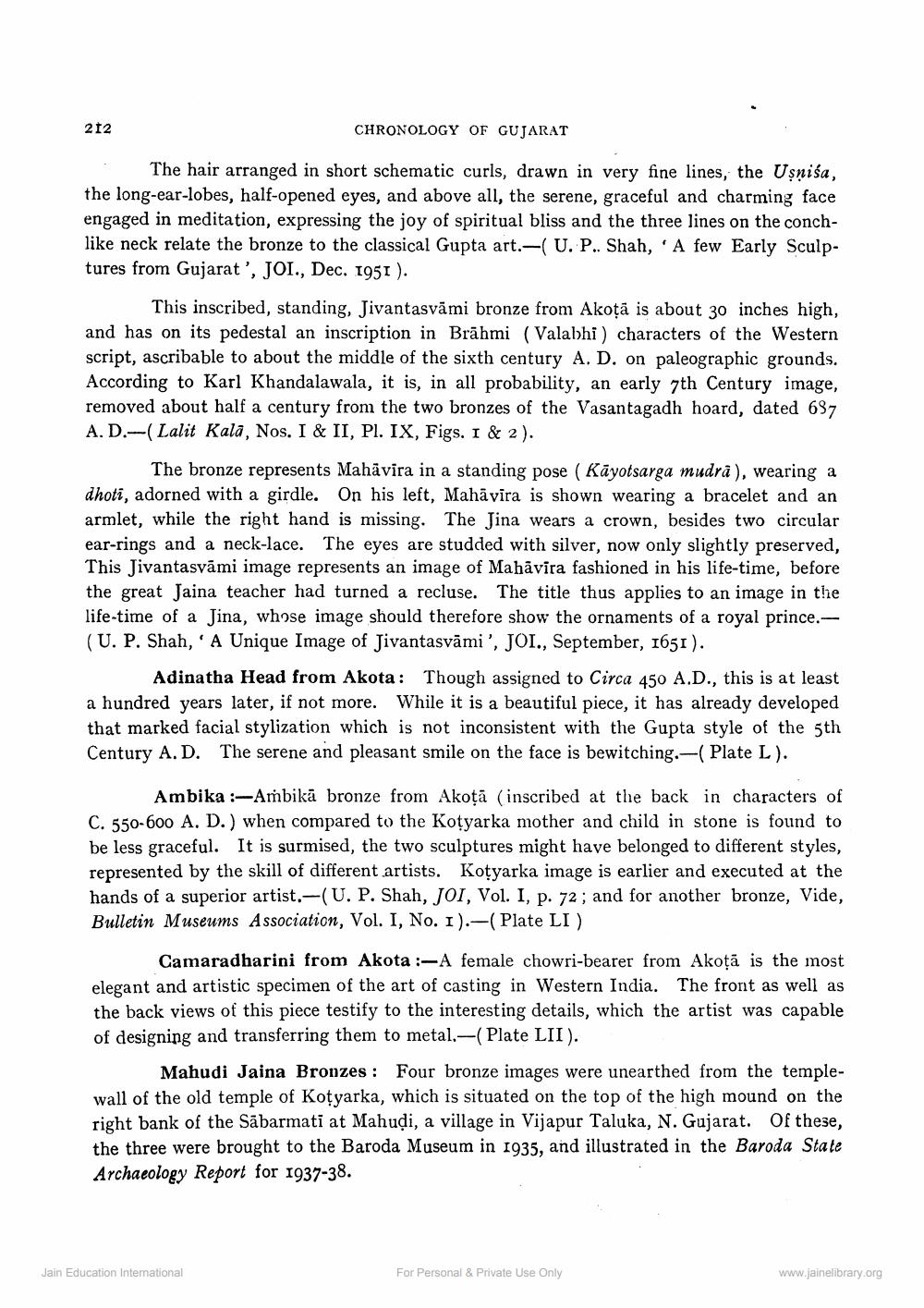________________
212
CHRONOLOGY OF GUJARAT
The hair arranged in short schematic curls, drawn in very fine lines, the Uşnisa, the long-ear-lobes, half-opened eyes, and above all, the serene, graceful and charming face engaged in meditation, expressing the joy of spiritual bliss and the three lines on the conchlike neck relate the bronze to the classical Gupta art.-( U. P. Shah, 'A few Early Sculptures from Gujarat', JOI., Dec. 1951 ).
This inscribed, standing, Jivantasvāmi bronze from Akoţā is about 30 inches high, and has on its pedestal an inscription in Brāhmi (Valabhi) characters of the Western script, ascribable to about the middle of the sixth century A. D. on paleographic grounds. According to Karl Khandalawala, it is, in all probability, an early 7th Century image, removed about half a century from the two bronzes of the Vasantagadh hoard, dated 637 A.D.--(Lalit Kala, Nos. I & II, Pl. IX, Figs. 1 & 2).
The bronze represents Mahāvira in a standing pose ( Kāyotsarga mudrå), wearing a dhoti, adorned with a girdle. On his left, Mahāvīra is shown wearing a bracelet and an armlet, while the right hand is missing. The Jina wears a crown, besides two circular ear-rings and a neck-lace. The eyes are studded with silver, now only slightly preserved, This Jivantasvāmi image represents an image of Mahāvira fashioned in his life-time, before the great Jaina teacher had turned a recluse. The title thus applies to an image in the life-time of a Jina, whose image should therefore show the ornaments of a royal prince.(U. P. Shah,' A Unique Image of Jivantasvāmi', JOI., September, 1651).
Adinatha Head from Akota: Though assigned to Circa 450 A.D., this is at least a hundred years later, if not more. While it is a beautiful piece, it has already developed that marked facial stylization which is not inconsistent with the Gupta style of the 5th Century A.D. The serene and pleasant smile on the face is bewitching.-( Plate L).
Ambika :-Ambikā bronze from Akoţā (inscribed at the back in characters of C. 550-600 A. D.) when compared to the Kotyarka mother and child in stone is found to be less graceful. It is surmised, the two sculptures might have belonged to different styles, represented by the skill of different artists. Koțyarka image is earlier and executed at the hands of a superior artist.-(U. P. Shah, JOI, Vol. I, p. 72; and for another bronze, Vide, Bulletin Museums Association, Vol. I, No. I).-(Plate LI )
Camaradharini from Akota :- A female chowri-bearer from Akoţā is the most elegant and artistic specimen of the art of casting in Western India. The front as well as the back views of this piece testify to the interesting details, which the artist was capable of designing and transferring them to metal.-(Plate LII).
Mahudi Jaina Bronzes : Four bronze images were unearthed from the templewall of the old temple of Koțyarka, which is situated on the top of the high mound on the right bank of the Sābarmati at Mahudi, a village in Vijapur Taluka, N. Gujarat. Of these, the three were brought to the Baroda Museum in 1935, and illustrated in the Baroda State Archaeology Report for 1937-38.
Jain Education Intemational
For Personal & Private Use Only
www.jainelibrary.org




